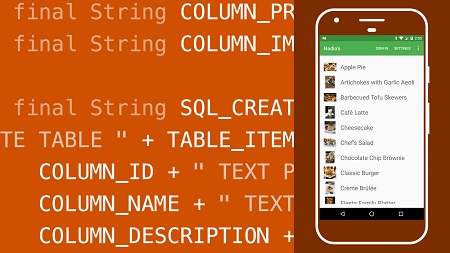
English | MP4 | AVC 1280×720 | AAC 48KHz 2ch | 3h 56m | 864 MB
Android developers who need to manage and present data have many tools available to them in the application framework of Android. This course covers a variety of data persistence techniques, including storing data in shared preferences—key-value pairs—in JSON-formatted text files, and in relational databases with SQLite. Join David Gassner as he demonstrates these data management techniques. He also explains how to use relevant design patterns to model data with Java classes, and how to present data to the user with the Android SDK’s ListView and RecyclerView components.
Topics include:
- Modeling data in POJO classes
- Customizing a ListView item display
- Displaying data in a RecyclerView
- Creating a custom array adapter
- Managing shared preferences with Java
- Creating and importing JSON data files
- Accessing SQLite from the command line
- Retrieving data with SQLite queries
Table of Contents
Introduction
1 Welcome
2 What you should know
3 How to use the exercise files
4 Review the starting app
5 Whats new in this update
Display Static Data
6 Model data in POJO classes
7 Manage data in Java collections
8 Display data in a ListView
9 Customize the ListView item display
10 Create a custom array adapter
11 Display image assets
12 Display data in a RecyclerView
13 Handle user events in a RecyclerView
14 Pass intent extras to detail activities
15 Pass parcelable objects as intent extras
16 Display detail data
Store Data in Shared Preferences
17 About shared preferences
18 Manage shared preferences with Java
19 Create a preferences activity
20 Listen for changes to a preference
Store Data in Text Files
21 Work with files in internal storage
22 Work with files in external storage
23 Create JSON data files
24 Import JSON data files
25 Bundle static data in a resource file
Manage Relational Data with SQLite
26 SQLite and Android
27 Create an SQLite database
28 Manage a database with a DataSource
29 Insert data into a table
30 Access SQLite from the command line
31 Retrieve data with SQLite queries
32 Filter and sort data
33 Manage SQLite transactions
Manage SQLite Databases with Room
34 Add Room library dependencies
35 Define Room entity class
36 Define an SQLite database with Room
37 Insert data with Room
38 Retrieve data with Room
39 Run Room queries in background threads
Conclusion
40 Next steps
Resolve the captcha to access the links!